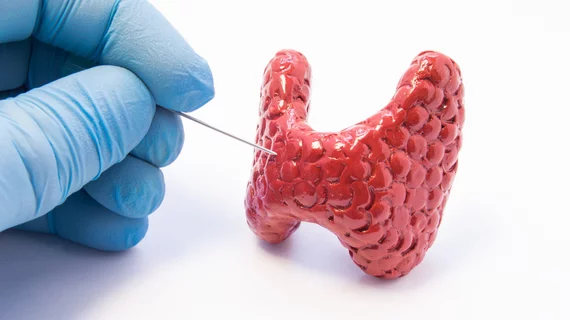The American College of Radiology’s thyroid risk categorization system recommends up to 50% fewer biopsies compared to other commonly used strategies, according to a new study.
In general, all risk stratification systems (RSSs) have similar fine needle aspiration guidance for highly suspicious nodules and those that are obviously non-cancerous. But such systems vary most among low-risk findings, and there’s been virtually no research into how that may impact follow-up recommendations, experts wrote Thursday in JACR.
After analyzing nearly 28,000 nodules, ACR’s Thyroid Imaging Reporting and Data System recommended FNA for 8,128 (29.1%) in a random adult population. This is 25%-50% fewer biopsies compared to other systems such as the American Thyroid Association guidelines, and European and Korean TI-RADS.
“The FNA recommendation rate is lower in our study than reported in the literature that compares RSSs in patient populations referred for FNA,” corresponding author Jenny K. Hoang, MBBS, MHS, MBA, with Johns Hopkins School of Medicine's Department of Radiology and Radiological Sciences, and co-authors wrote. “This suggests that ACR TI-RADS may have an even greater impact on reducing biopsy recommendations than previously recognized.”
The lower number is largely due to the system’s higher FNA thresholds for risk levels 3 and 4, and the categorization of more nodules as risk level 2, which don’t require fine needle biopsy, the authors noted.
In fact, the ACR TI-RADS suggested the lowest number of biopsies for TR3 and TR4 nodules compared to the other systems, reaching 18% and 30%, respectively.
Hoang et al. based their findings on seven practices’ prospective ultrasound reports submitted between October 2018 and March 2020. Overall, the cohort included 12,208 patients and 27,933 nodules.
The authors did note that the reduced FNA recommendations can lead to false-negative results, but ACR TI-RADS is set up so that most malignant nodules would undergo a subsequent ultrasound or follow-up of some kind.
One of the “major” limitations of this study was the lack of long-term follow-up and pathology results, meaning the team did not determine if nodules not recommended for biopsy turned out to be missed cancers. But Hoang and co-authors maintained their findings are important for the field.
“The current study differs from prior work in that the RSSs were applied to nodules that were reported on ultrasound in an unselected adult population, whereas many studies focus on a patient population referred for FNA,” the group wrote. “By evaluating this population, we obtained insight into the impact of RSSs on diagnostic thyroid ultrasound management recommendations.”

